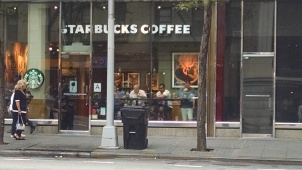I was lucky enough to attend The Big Rethink US 2014 Conference delivered by  The Economist and further supported by MENG. The discussions surrounding big data, social networking and customer engagement crossed almost every industry. In this blog post, I will share twelve highlights from the March 2014 conference; they are in no particular order. For additional twitter streams, check out #BigRethink, @TheIdeasEconomy and @sharonlewisnyc.
The Economist and further supported by MENG. The discussions surrounding big data, social networking and customer engagement crossed almost every industry. In this blog post, I will share twelve highlights from the March 2014 conference; they are in no particular order. For additional twitter streams, check out #BigRethink, @TheIdeasEconomy and @sharonlewisnyc.
1.Real Time Marketing
This is the Holy Grail that we marketers seek to achieve with confidence, reliability and available budget parameters. The concept behind achieving this is to set up multi-functional teams that are empowered to be spontaneous within a pre-determined set of boundaries. Huh?? Is this possible?
Yes. The example was the 2013 SuperBowl Dunk in the Dark Oreo campaign. With a zero media spend; one tweet generated 525 million media impressions.
2.Data Context: Opt-in May Still Need a Human Intervention to Avoid Bad Assumptions
At @1800Flowers, they do not assume that you send the same person a Valentines’ Day bouquet every year! In a similar vein, you cannot re-use the data that you collect for an arrangement being sent for a funeral or for condolence purposes. Enough Said!
3. Our attention span has become so short that we do not take the required time to explore many worthwhile options. Here are two examples:
Remember the amount of time that what went into making a 30 second or 60 second commercial? Our requirements for immediate gratification (read: short attention spans), have further crept into the creative process. What happened to the evolution of an idea? Some speaker discussion suggested that similar to the final campaign, the creative process has become one that demands instant gratification. As such, we may be pre-maturely eliminating some great campaigns and bottom line results.
As it relates to getting the consumer to the action stage of the offer: @MaryKayUS spoke about a mobile – first strategy with the goal of accomplishing any action within two clicks. …. “Making it easy for the soccer mom en route to the practice field” to be productive……. @SherryAG That does sound pretty close to instant gratification!
4. We have too many channels of vertical expertise. This impacts our corporate structures and our recruitment efforts
Comments from the CMOS of Lowe’s and The Weather Company spoke to trying to break down the vertical channels of expertise. As an industry, we have already established many proven formulas for successful, relevant marketing. While the quantity of the messaging channels has changed, and the available channels for marketing have changed…… The principles of relevant messaging and singular focus to action have not changed.
A good marketer can learn the nuances of a unique communications channel; Good marketing skills are applicable across any vertical channel. Hence why do we suggest otherwise in our (formal and informal) recruitment and career development policies?
5. “Say what”…….Whose language are you speaking? Whose perspective are you sharing?
There was an “aha moment” when the McCann Truth Central story was shared about a focus group participant stating that they engage in low rates of text messaging. Further probing revealed that this young adult had some 300 text messages daily; another participant piped in to say that they wake up some mornings to 1000 messages on their phone. @McCannTruth @TruthLaura
Lesson reiterated: Perceptions are everything. Probe and define the perception from which one speaks!
6. Crisp, singular messaging is nothing new and should continue to be a mantra for good communications.
Remember the old adage for a good billboard ad: six words or less! Why do we act surprised when the role of crisp singular messaging is re-proven with each new communications channel that we invent?
7. Data Sharing and Privacy
There are conceptual lines that consumers use in determining how/when/what they share. Brands are starting to learn that consumers are more aware than ever that they are sharing and that when they do… “They want something back for it”. Many of the speakers noted that they have received customer complaints from those feeling that their data was not being maximized. Again, this creates a fine line in differentiating a personalized experience from a Yuk factor, also known as a “creepy factor”. The app for a healthier lifestyle called @Noom, spoke to their success in the creation of trusted on-line weight-loss support groups; Caesar’s Entertainment spoke about real time data updates regarding the preferences of their clientele.
8. Data Context, Data Filters and Timely Data vs Relevant Data
A real time, big picture challenge that continues to be tested by marketers are the models behind: How does a brand insert themselves into a conversation that is appropriate and relevant to the customer experience?
• Here is where mobile is changing the retail shopping experience.
• Here is where content is being taken to new levels of storytelling, relevancy and entertainment (interpreted as three distinct and intertwined objectives).
• Here is where the concept of “filter failure” needs to be fine-tuned for efficacy and relevancy.
9. Would this ad prompt someone to want to see the ad again?
It seems logical that re-watching an ad is an important criteria to wanting to share the ad, thereby allowing it to go viral. Music videos being replayed on YouTube are a great example. The “Lowe’s Fix in Six,” vine series offers simple, everyday improvements that could also fit into the category of a “want to replay it”. The Apple ads that speak to what you can do with an apple product were touted as another example.
It is hard to predict what will spark a viral reaction; it is easier to go with creating something that people simply want to see/hear/experience again.
10, Note-taking was visual and intrigued everyone in the audience. Take a look
11. Analysis Paralysis
With data exploding at unparalleled rates, projects quickly become so big that they are scary—even to the best minds in quantitative model development. The presenters advised that we all just get in there and start doing it — not everyone can have the big budgets, however everyone can create learning environments.
12. Funny Expression of the Day
The budgets available to test, measure and deliver were never stated during the conference. SVP and CMO of Frito-Lay North America enthusiastically shared some memorable experiential campaigns with the audience. And, with such stories, she had us all laughing with the expression: “The juice is worth the squeeze”.
In closing: I will paraphrase an organization that was not represented at the conference: “Ya gotta be in it to win it”
Wishing us all much positive learning in our campaign endeavors.
This blog originally posted in March 2014 through the mengonline.com community via http://mengonline.com/blog/2014/03/18/reflections-economists-big-rethink-360-cmo/


 as a 1/4-inch drill
as a 1/4-inch drill





 When was the last time you grabbed a cup of coffee or a snack because you walked by the storefront window, saw it and thought “Yeah, I would like one of those!”
When was the last time you grabbed a cup of coffee or a snack because you walked by the storefront window, saw it and thought “Yeah, I would like one of those!”

